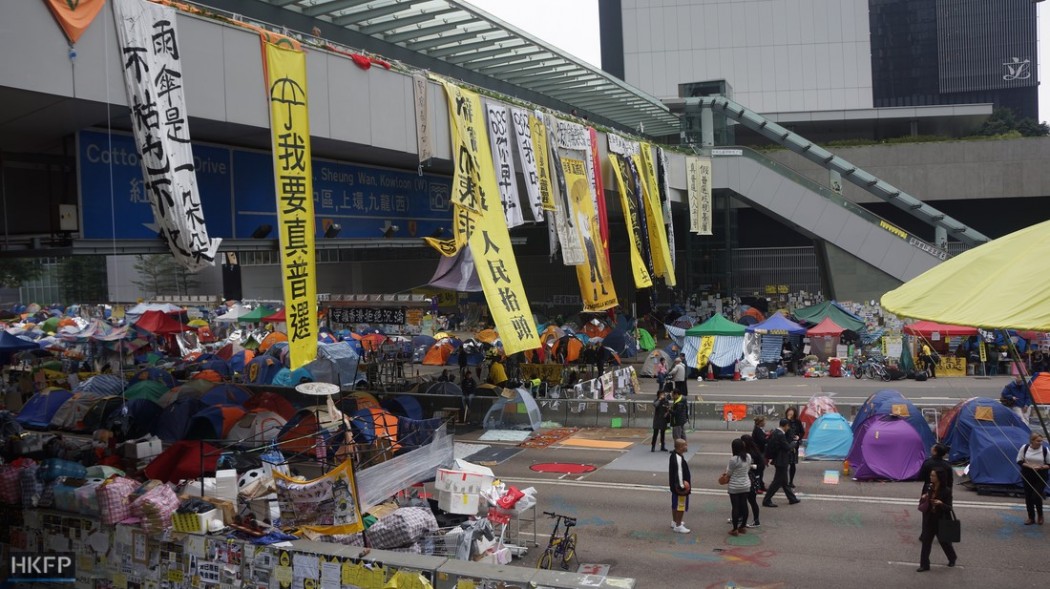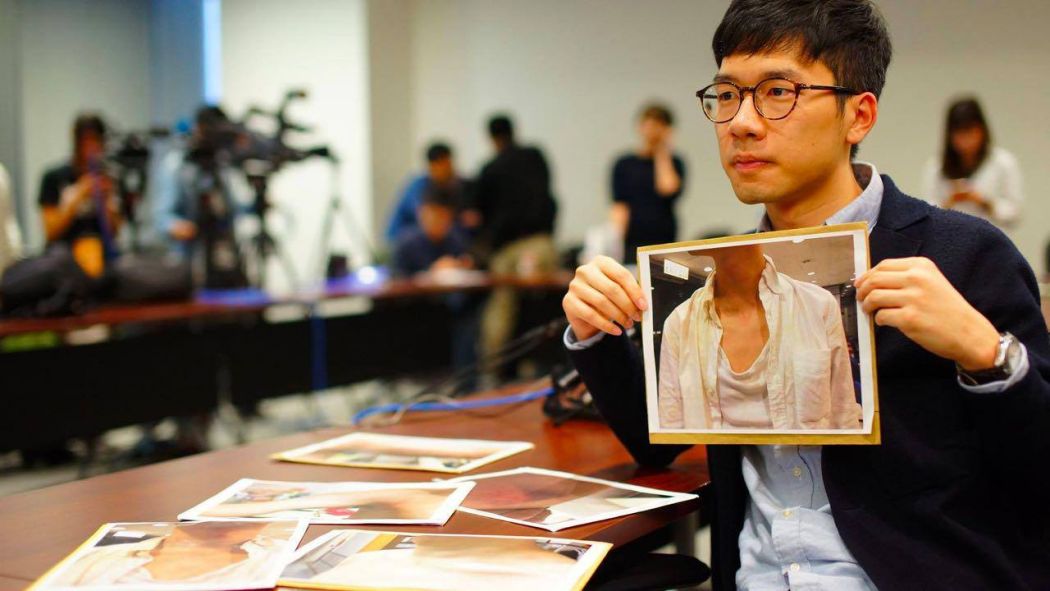Let me narrate the development of protests in Hong Kong since the pro-democracy Occupy protests of 2014. I wrote about what was happening at the time. Now in 2017, as Hong Kong’s imminent Cultural Revolution starts to gain more traction, it seems appropriate to recall what happened.
This will help with the question why, in 2017, elected lawmakers can be assaulted by Communist thugs at the airport with impunity. We didn’t get to the edge of mainstream political violence by accident. Everyone’s actions or lack of action contributed to this.

Directly after Occupy, activist Joshua Wong and Scholarism said the protests were more or less a failure, so they would go to the street to educate citizens about political reform. Within hours, Scholarism booths and Joshua Wong were attacked by shady, middle-aged figures whose political agenda was to punch anything they didn’t understand.
Civic Passion also took to the streets to further their growing localist agenda, which was gaining momentum. Civic Passion booths were also attacked on numerous occasions. One such violent incident saw six Hotdogs (a colloquial term for a Civic Passion supporter) assaulted in Kwun Tong. All their flags and paraphernalia were destroyed. Then the six assault victims were arrested while the violent perpetrators walked away in plain sight of the police.

I wrote about it at the time, and it seems even truer today that somewhere a shady order had gone out not to let the message of Occupy continue onto the streets in 2015. The young voices of Occupy could not continue to spread their message unfettered throughout society.
As there were no laws preventing kids from setting up political booths, the job would be handled by the motley crew of democracy haters known as The Blue Ribbons, led by their rising star Leticia Lee.
Fresh from chasing both Scholarism and Civic Passion off the streets in the last week of December 2014, Leticia and her cohorts organized their own New Year’s day rally in Tai Po. But things didn’t go quite to plan. A new kid was about to explode onto the block; Hong Kong Indigenous.
HK Indigenous’s break-out protest had only one goal in mind. To shut down the Blue Ribbons’ rally and run Leticia off the street. This was fighting fire with fire. At the time, being a wishy-washy leftist liberal, I thought it was misguided and served no political purpose, especially as it took place on the same day as the first, big march since Occupy in Central.

But it quickly proved to be a political master-stroke that stopped the Blue Ribbon movement in its tracks. After Tai Po, those organizing any Blue Ribbon intimidation campaigns knew that they couldn’t mobilize enough thugs to counter the growing HK Indigenous movement. These kids were tougher, smarter and more committed than the jobless, hapless, unreliable Blue Ribbons.
Police had to mobilize on a grand scale, and by the time the smuggler protests were in full swing, the Blue Ribbon movement had been reduced to a small sideline of abusive hecklers. They simply didn’t have the manpower to match HK Indigenous.
At this point in the narrative, we arrive at a point that is relevant for today. HK Indigenous effectively kicked the stool from underneath a rising Blue Ribbon Movement, and thugs as a tool of political repression fell out of favour. Scholarism and other street organizations were then able to carry on their work with only minimal disturbance.
Great move HK Indigenous, but… their legacy is that they temporarily stemmed the use of thugs in street politics, but they brought down an avalanche of state-organized political violence upon themselves.

Regardless of what you may have read in the papers or seen on the TV, I witnessed first-hand every one of their protests. I was often just yards away when the most newsworthy incidents happened, and there is no doubt in my mind that there was a concerted effort by the police to instigate violence and chaos, and selectively police the protests, so that the protests could be cast in a dark light the next day in the media.
At the time I wrote that what the police and government were doing to HK Indigenous at the smuggler protests they would do to mainstream democratic protesters in the future.
Many in the mainstream democratic camp bought into the police tactic and lined up on a Monday morning to condemn HK Indigenous, their direct protest tactics and their willingness to resist political intimidation, despite the huge evidence of police abuse and manipulation.
The smuggler protests ended abruptly just as they were gaining momentum. Later I asked an HK Indigenous member why that happened and he said that the protests were becoming too costly for the protesters.

Believe it or not, the aim of the protests was never to go and cause chaos and fight with the police. Certainly a few protesters did engage in anti-social behavior, but this was a tiny fraction. The protests were genuinely about raising the issue of smuggling. But the government by then had a new agenda.
Unable to use low-level thugs to scare demonstrators off the street, the government and police began to use methods like swamping protests with hundreds of jumpy, agitated police and arresting ringleaders on trumped-up charges. This would then enable the politicized Department of Justice to hobble active members for months or years with legal troubles.
Nine tenths of all the brutal arrests I witnessed were for nothing. Most people, after being brutalized by the police, were released on never-ending cycles of bail and court appearances. At the time I wrote that what they’re doing to these localist kids now, they’ll do to the mainstream democratic supporters in years to come if we don’t show them support and unity.
However, indignation at their treatment and support from the mainstream never materialized. It was easier to believe in the government narrative that these kids were just trouble-makers, and they were somehow separate from the righteous fight to bring democracy to Hong Kong.

People refused to believe that the government was just getting started on HK Indigenous and was in fact road-testing a solution for all democratic dissent in a future Hong Kong.
Fast forward to 2017 and most of our mainstream political figures are now, surprise, surprise, tied up in endless court cases. A model the government formulated when it was demonizing HK Indigenous.
On top of this, low-level political intimidation by Communist thugs is now making a come-back, as the outer defences against such violence have been neutralized and vilified.
Hong Kong is on the cusp of a violent Cultural & Political Revolution. Politically motivated youths are marginalized and assailed with lawfare on every front from a relentless government, a politicized Police Force and the shadowy Party.

But still many people prefer to condemn those who are willing to stand up and vehemently resist these dark forces. Political intimidation is only set to rise as there is no one to defend the likes of Nathan Law when thugs beat him up at the airport.
Our outer defences against political violence have been depleted through lack of support, and now the shady henchmen see an opportunity to mobilize thugs at every turn with impunity.
Until we get some steadfast resistance to political violence back, commie thugs will make a resurgence and run amok over Hong Kong’s civil society in a Cultural Revolution 2.0.
